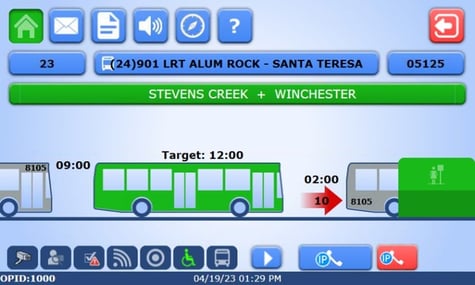Bus bunching is one of a transit agency's most common — and most complicated — problems. Imagine you're a busy commuter on your way to work. You rely on public transportation to get you there on time, but when you arrive at the bus stop, you see that several people are already waiting. You check the schedule, and it says the next bus should arrive in 10 minutes. You settle in to wait, but as the minutes tick by, you start to get anxious. What if the bus doesn't show up? Will you be late for work? Suddenly, you see two buses approaching the stop at the same time. You breathe a sigh of relief, thinking that you won't be late after all. But as the first bus pulls away, you see that the second bus is right behind it, almost bumper to bumper. The bus driver apologizes for the delay, saying they got caught in traffic. You and the other passengers are frustrated, knowing you'll be late for work despite the two buses arriving simultaneously.
This scenario illustrates the frustration and inefficiency that can result from bus bunching. For transit agencies, it's a complex problem that requires careful management of headway and constant monitoring of traffic conditions. Addressing bus bunching is essential for providing passengers with a safe, efficient, and enjoyable commuting experience. But how can an agency take steps to alleviate the issue of bus bunching without adding more vehicles on the street?
Utilizing Onboard Headway Management Tools to Ease Bus Bunching
 With the CleverCAD Headway management module, dispatchers can switch the operator's onboard transit control head (TCH) to headway management mode during rush hour or other high traffic times to help ease bus bunching before it even occurs.
With the CleverCAD Headway management module, dispatchers can switch the operator's onboard transit control head (TCH) to headway management mode during rush hour or other high traffic times to help ease bus bunching before it even occurs.
This allows the operator to monitor the headways between their bus and the one in front of them to help them adjust their speeds accordingly. By doing this, the system can help to maintain consistent spacing between buses, reducing the likelihood of bus bunching.
One of the benefits of using CleverCAD headway management is that it allows vehicle operators to focus on their driving rather than worrying about maintaining a specific schedule. This can help reduce stress and fatigue, improving safety and reducing the likelihood of accidents. CleverCAD headway management helps to improve the overall quality of your service and allows vehicle operators to keep their eyes on the road.
What If Onboard Headway Management Isn't Enough?
When switching to headway management mode is insufficient, an agency can also utilize Disruption Management to combat bus bunching. Disruption Management involves re-routing or diverting a vehicle to reduce bunching. It can be done in real time, allowing the agency to quickly respond to changing traffic conditions or other disruptions.
While the CleverCAD headway management module may not solve bus bunching entirely, this powerful tool can help transit agencies improve the reliability of their services by focusing on factors within their control. To explore the powerful tools and modules available in CleverCAD, download our eBook to learn more.